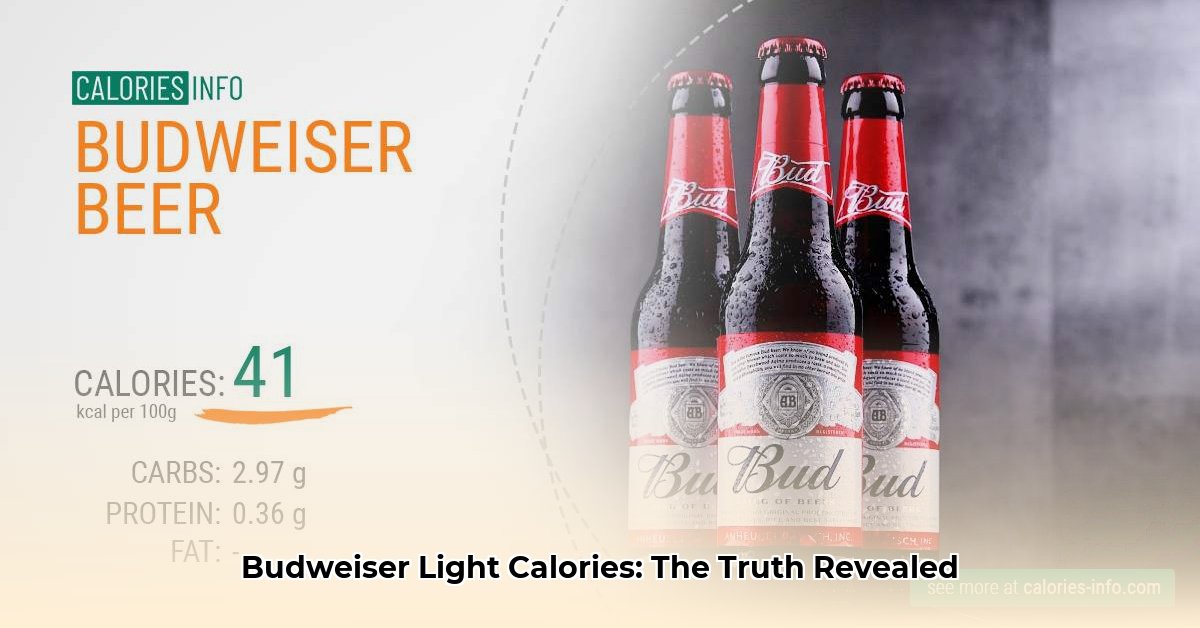So, you’re trying to be mindful of your calorie intake but still want to enjoy a beer now and then? Figuring out exactly how many calories are in your favorite brew can be tricky. This article cuts through the confusion surrounding Budweiser Light, a popular choice for those watching their weight. We’ll look at the calorie count, break down the ingredients, and compare it to other light beers. We’ll even dive into why you might see different numbers depending on where you look and what that means for you. Get ready to become a Bud Light calorie expert!
Calories in Budweiser Light: A Nutritional Deep Dive
Let’s talk about Budweiser Light and its calorie count. It’s a popular choice, especially for people watching their weight, but pinning down the exact number of calories can be surprisingly tricky. You’ll find slightly different numbers depending on where you look – maybe 103 calories in one place, 110 in another. Why the variation? It’s a mix of things. Minor differences in how the beer is brewed, variations in testing methodologies, and even rounding practices when reporting nutritional information all contribute to these discrepancies.
Unpacking the Nutritional Label: What’s Really Inside?
So, what’s actually in a Budweiser Light? Predominantly, you’ll find water, barley malt, rice, and hops. The calorie contribution primarily comes from alcohol and carbohydrates. A 12-ounce serving typically contains around 4.2% ABV (alcohol by volume). Let’s break down the approximate nutritional content for a standard 12-ounce serving:
- Calories: 110
- Carbohydrates: 6.6 grams
- Protein: 1 gram
- Fat: 0 grams
- Sodium: 5mg
While the carbohydrate numbers may show some variation depending on the source, the overall profile makes Bud Light a relatively light choice compared to regular beers.
The Light Beer Landscape: Budweiser Light and Its Rivals
The low-calorie beer market is fiercely competitive. Miller Lite, Coors Light, and Michelob Ultra are all vying for your attention. While the calorie counts might be similar, there are subtle differences in taste, ingredients, and marketing. Here’s a quick comparison:
- Budweiser Light: Approximately 110 calories
- Miller Lite: Approximately 96 calories
- Coors Light: Approximately 102 calories
- Michelob Ultra: Approximately 95 calories
Ultimately, choosing a beer is about more than just calories. Personal preference plays a significant role.
Decoding Inconsistent Data: Understanding Calorie Variations
Why does the calorie information for Budweiser Light sometimes seem inconsistent? One source might list 103 calories, while another reports 110. These small discrepancies can arise from several factors:
- Brewing Process Variations: Slight adjustments in the brewing process can affect the final calorie count.
- Testing Methodologies: Different labs may use slightly different methods for measuring calorie content.
- Rounding Practices: Nutritional information is often rounded, which can lead to minor differences in reported values.
Consumers should recognize that these variations are typically small and don’t significantly alter the overall nutritional profile of the beer.
Regulations and the Quest for Transparency
The inconsistencies in nutrition facts raise questions about regulations and labeling practices. Clear and consistent labeling for alcoholic beverages is essential for informed consumer choices. While the Alcohol and Tobacco Tax and Trade Bureau (TTB) oversees the alcohol industry, labeling requirements can sometimes lag behind consumer demand for more detailed nutritional information. Enhanced transparency in labeling would empower consumers to make better decisions about their alcohol consumption.
Tips for Informed Choices
As a consumer, you can take several steps to make informed choices:
- Consult Multiple Sources: Check nutrition facts from various reliable sources, including the brewery’s website and reputable health and nutrition websites.
- Focus on Overall Nutrition: Don’t just look at calories; consider the beer’s entire nutritional makeup, including carbohydrates, protein, and fat.
- Practice Moderation: Regardless of the calorie count, moderation is key to responsible alcohol consumption.
- Consider Alternatives: Explore other light beer options or non-alcoholic alternatives if you’re looking to further reduce your calorie intake.
The Bottom Line: Navigating the World of Light Beer
Our exploration of Budweiser Light’s calorie count highlights the importance of critical thinking and informed decision-making. While Budweiser Light is generally a lighter option, inconsistencies in nutritional information underscore the need for better industry standards and clearer labeling. By consulting multiple sources, considering the overall nutritional profile, and practicing moderation, consumers can confidently navigate the world of light beer and make choices that align with their health goals.
How to Compare Bud Light Nutrition Facts Across Different Sources
Key Takeaways:
- Bud Light generally contains around 110 calories per 12-ounce serving, although minor differences can be found across different sources.
- Compared to its competitors like Coors Light and Miller Lite, Bud Light has a slightly higher calorie count.
- Variations in brewing processes and measurement techniques can influence the final calorie count.
Deciphering the Calorie Count: Understanding the Numbers
When trying to make informed choices about your beer consumption, it’s crucial to understand the calorie content. However, finding consistent information on Bud Light’s calorie count can be challenging. This is where knowing how to compare Bud Light nutrition facts becomes essential.
Several factors contribute to a beer’s final calorie count. Subtle differences in brewing procedures, the ingredients used, and the measurement techniques employed by different sources can all impact the final number.
Generally, Bud Light contains approximately 110 calories per 12-ounce serving. This figure remains relatively stable across various sources. However, you might encounter minor discrepancies. Does this mean the information is unreliable? Not necessarily. It simply emphasizes the inherent complexities of accurately measuring calorie counts.
Here’s a comparison of Bud Light and its main competitors:
| Beer | Approximate Calories (per 12oz) |
|---|---|
| Bud Light | 110 |
| Coors Light | 102 |
| Miller Lite | 96 |
| Michelob Ultra | 95 |
| Budweiser | 145 |
As you can see, Bud Light falls in the middle range, providing more calories than the lightest alternatives but significantly fewer than its heavier counterpart, Budweiser.
Variations and Added Ingredients
Bud Light’s calorie count isn’t fixed. The introduction of Bud Light Next, which has significantly lower calories and carbohydrates, illustrates this point. This reduced calorie count is accomplished through a different formulation that minimizes both alcohol and carbohydrates. A 12-ounce serving of Bud Light Next contains only 80 calories and 0 grams of carbohydrates.
Keep in mind that flavored Bud Light variants such as Bud Light Lime or Bud Light Orange will have a noticeably higher calorie count than the standard Bud Light due to extra sugars and other components. These additions significantly increase the overall calorie and carbohydrate content.
Navigating Nutritional Information
To effectively compare Bud Light’s nutrition facts, use a structured approach:
- Use Reliable Sources: Stick to credible sources like the official Budweiser website, trusted health and nutrition websites, and government databases. Avoid less reliable sites or those with obvious biases.
- Check Serving Sizes: Always verify the serving size (usually 12 ounces). Changes in serving size greatly affect calorie calculations.
- Look for Consistency: If multiple sources report similar calorie counts, you can have more confidence in the figure. Approach large discrepancies with caution.
- Consider Added Ingredients: If you’re examining flavored variants of Bud Light, expect a higher calorie count than the original.
- Understand Limitations: Recognize that small variations are inherent in the process of producing and measuring the nutritional content of beer.
By following these steps, you’ll be better prepared to find and assess the nutritional information for your favorite beer, enabling you to make well-informed choices that support your health goals. Remember, even small differences can matter over time, but it’s important to consider the overall picture when managing your diet and lifestyle.
Budweiser Light Beer: A Comparative Analysis of Nutritional Labeling Practices Across Various Sources
Key Takeaways:
- Budweiser Light consistently has fewer calories and carbohydrates than regular Budweiser.
- Nutritional data varies across sources, highlighting the need for standardized labeling.
- Consumers need to understand these variations to make informed dietary choices.
Unpacking Calories and Carbs: The Core Numbers
Most sources agree that Budweiser Light is lighter in calories and carbohydrates than Budweiser. A typical 12-ounce serving of Budweiser Light has around 110 calories and 6.6 grams of carbohydrates. In contrast, Budweiser contains about 145 calories and 10.6 grams of carbohydrates per 12 ounces. That’s a notable difference!
The difference comes from changes in the brewing process. Budweiser Light likely uses different proportions of malt and adjuncts, making it leaner. However, keep in mind that these are estimations; slight variations appear across sources, showing how difficult it is to standardize nutritional information for alcoholic beverages.
The Great Discrepancy Debate: Why Numbers Don’t Always Align
Why the inconsistencies? The problem is multifaceted. Different testing methods, rounding practices, and even batch variations all
- Water Wheel Electric Generator Provides Free Home Electricity - December 15, 2025
- Choosing the Right Portable Hydro Turbine for Your Needs - December 14, 2025
- Best Portable Hydro Generators for Off-Grid and Outdoor Power - December 13, 2025















